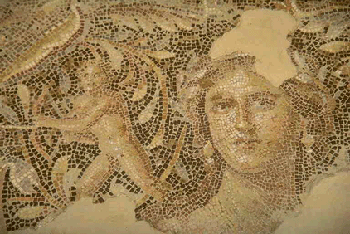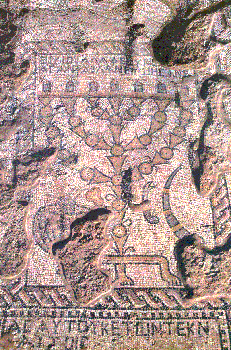Zippori
|
The city of Zippori (Sepphoris) is located on a hill in the Lower Galilee, midway between the Mediterranean and Lake Kinneret (Sea of Galilee). The city dates to the era of the Maccabees in the second century B.C.E., when it was founded by Alexander Janneus of the Hasmonean dynasty. Zippori was described by the first century C.E. Jewish historian, Josephus Flavius, as "the ornament of all Galilee." The city may get its name from the Hebrew word "tsipor" (bird) because the view from the town gives a sense of flying. Zippori is mentioned in many Jewish sources of the first centuries of the common era. Founded in the Hellenistic era by Alexander Janneus, it was captured by the Romans in 37 B.C.E. when the inhabitants fled in the midst of a snowstorm. A rebellion against Herod's control of Zippori was suppressed and the King's son, Herod Antipas rebuilt the city and renamed it Autocratoris. The Roman governor, Gabinius, later made Zippori the administrative capital of Galilee in the mid-first century B.C.E. The Jews did not join the revolt against Rome in 66 C.E.; instead, they opened the city gates to the legions of the Roman Emperor Vespasian and surrendered. On coins minted in Zippori at that time, the city is named Eirenopolis, "city of peace." Later, its name was changed to Diocaesarea in honor of Zeus and the emperor. The Jewish community grew when thousands of refugees from Judea moved to towns in the Galilee following the Bar-Kokhba revolt of 135 and Zippori became the center of Jewish religious and spiritual life in the Land of Israel. Rabbi Yehuda Hanasi, who compiled the Mishnah, lived in the city for 17 years and relocated the Sanhedrin (the supreme Jewish religious and judicial body he headed) to Zippori in the third century. At least 18 synagogues were functioning in the city around this time and Jews constituted the majority of the town's population. Even after the seat of the Sanhedrin was moved to Tiberias, Zippori remained a center of Bible study and notable sages taught in its numerous academies. Also, its location on or near major trade routes in the lower Galilee, made Zippori a prime market for traders. The discovery of rich, figurative mosaics during excavations at Zippori provide evidence of the Roman character of the city's pagan population, which coexisted in harmony with the Jews during the period of economic prosperity in the late Roman period. Zippori was destroyed in 363 by an earthquake, but was rebuilt soon thereafter, retaining its social and spiritual centrality in Jewish life in the Galilee.
The city is also the traditional birthplace of Mary and just four miles of Nazareth, the home of Jesus. During Byzantine times, the Christian community in Zippori grew considerably. This growth was accompanied by the construction of many churches and by Christian involvement in municipal matters. It became the seat of a Christian bishopric in the 5th century CE. Following the Arab conquest in the mid-seventh century, the city declined. Under Crusader rule during the 12th century, a small watchtower and a church (dedicated to Anne and Joachim, parents of Mary, mother of Jesus) were built on the city's hilltop. The remains of the watchtower, partly renovated in later times, still dominates the hilltop today. Since 1990, large areas of Zippori have been excavated. The finds have included public buildings and baths, residential areas, an amphitheater, market building, industrial installations, mikvot, cisterns, a complex drainage system and a great deal of glass. Of particular interest are the ruins of a 4,500-seat Roman amphitheater and a mosaic inside a villa that has the depiction of a beautiful young woman that is referred to as the "Mona Lisa of the Galilee." Archaeologists also discovered the narrowest ancient synagogue in Israel, measuring only about 68 feet (20.7 m.) long and 27 feet (8 m.) wide, which has a beautiful mosaic floor decorated with a zodiac and pictures of Temple objects and Biblical scenes. |
| Previous | Next |





